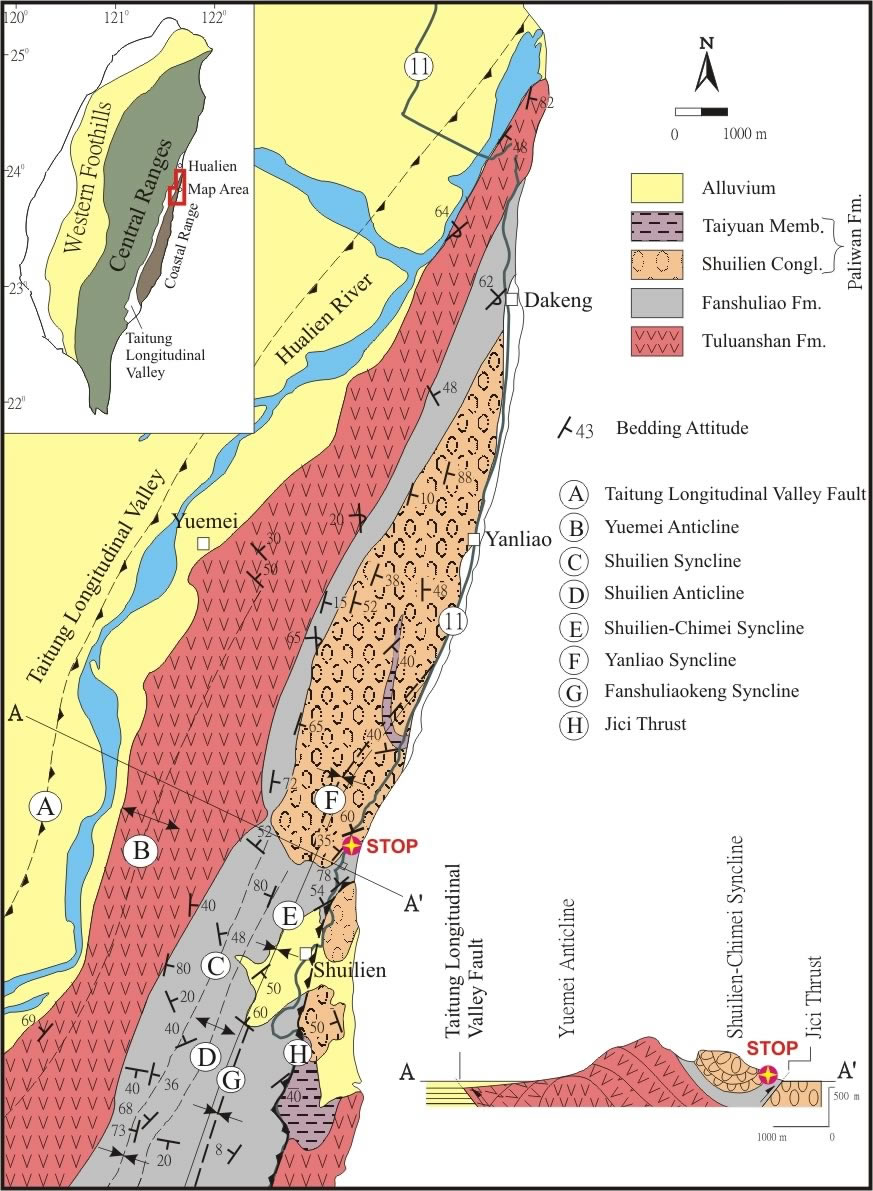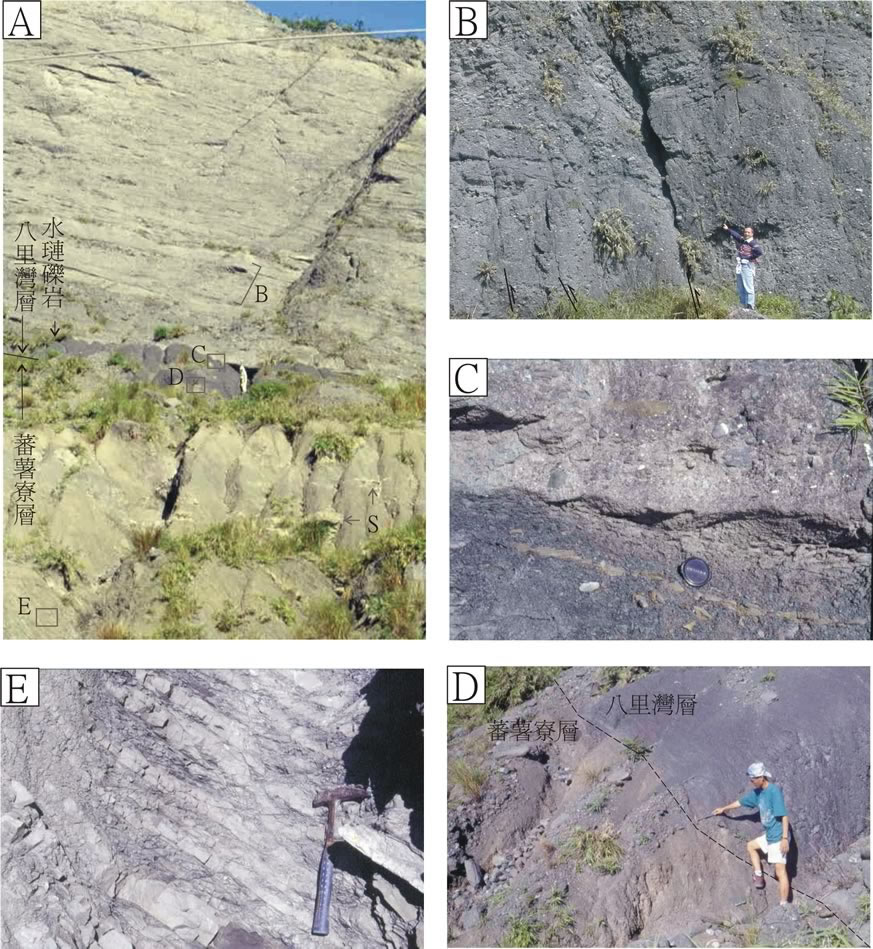Shuilien, Bridge no. 15 of Road no. 11: Formation boundary between
the fine-grained forearc deposits of the Fanshuliao Formation and the coarse-grained
Paliwan Formation
Stop 4-3 (see Fig. 27 for stop location) shows both the Fanshuliao and Paliwan
Formations of forearc deposits. Sediments of the Fanshuliao Formation were first
brought in by turbidity currents and deposited at the base of the Luzon volcanic
arc slope as turbidites, which later slid into the forearc basin with submarine
slumps (Teng et al., 2002). The Paliwan Formation comprises mainly of resedimented
conglomerates (i.e., Shuilien Conglomerate) in the northern Coastal Range. These
coarse-grained turbidites were accumulated in the setting of deep-sea upper
fan (Teng, 1982).
下述區域地質說明摘自何春蓀(1986)「台灣地質圖概論-台灣地質圖說明書」。經濟部中央地質調查所出版,台北,共164頁。:
大港口層 都巒山層的上面為一個厚的火山岩質碎屑岩系 (volcaniclasticsediments) 所覆蓋,這一個岩系由頁岩、砂岩和礫岩混合著火山物質成。在地質製圖上,徐鐵良
(1956) 曾將這巨厚的碎屑岩系分成兩個岩層組合,在下部的是礫岩--頁岩--混濁砂岩系,在上部的是頁岩--混濁砂岩系。前面的被稱為大港口層,後面的被稱為奇美層,兩個地層的標準地點都在海岸山脈中部的秀姑巒溪上。因為這兩個地層是漸變的,所以沒有清楚的界線存在。這兩層岩性的區分似乎只能反映局部地區中同一沉積岩體的岩相變化而已,畢慶昌
(1969) 認為在區域地質研究上可以把這兩地層合併為一層較為方便,稱之為大港口層。在小比例尺的地質圖上,大港口層已為大家接受作為這個富含火山岩質的巨厚碎屑岩系的代表。
大港口層大部分由沉積碎屑岩和火山質碎屑岩組成,是沉積在火山弧西側的層狀海相岩層; 在局部火山活動中止地區,則疊覆在火山弧之上,大港口層底部偶而可以找到安山岩的巨礫。大港口層的沉積物大致反映出一個較深海的沉積環境,其厚度可達三千至四千公尺。在海岸山脈南部地區,大港口層多為深灰色的泥岩、粉砂岩、及厚薄不一的砂岩,局部也含礫質泥岩及傾瀉岩塊,後者產狀和以後要討論的利吉混同層者相似。傾瀉岩塊中有蛇綠岩屑及含中新世化石的沉積岩屑
(紀文榮等人,1981) 。在海岸山脈的北部,大港口層的主要岩性是粉砂岩及泥岩,偶夾薄層砂岩,但在岩層的中部及上部有由不同岩類組成的礫岩厚層,厚度可達數百公尺。礫岩中的碎屑物大部為與中央山脈的板岩相似的板岩及變質砂岩,另外也有少量的蛇綠岩及安山岩碎片。
發育良好的濁流沉積構造是大港口層碎屑岩中的特徵,特別是下部的砂岩,因之王超翔及陳宗梓 (1966) 曾稱海岸山脈南部的大港口層為濁流層。砂層常有分級層的構造,在局部地區,旋卷層、流槽鑄型、重荷鑄型、槽鑄型、及其他的底痕構造非常明顯
(徐鐵良,1954 ; 黃富文,1977),此外準同時的崩移滑動構造也很普遍。這些現象都可以顯示弗立希岩相或濁流岩的沉積作用,這在世界上主要造山帶中都佔重要地位。臺灣西部褶皺衝斷帶的碎屑岩中很少這種標準濁流岩的沉積構造,縱有亦發育不良;
這是這兩個位於不同地質區中的地層在沉積構造環境上主要的區別。
大港口層內有大量的海相微體化石及極少的軟體動物化石,據張麗旭 (1967,1968及1969) 的研究,頁岩質沉積物中的有孔蟲的時代從中新世晚期到上新世,以上新世為主。最近超微化石的生物地層研究
(紀文榮等人,1981) 顯示大港口層的時代在上新世早期到更新世早期之間,通常大港口層的時代與其下伏的都巒山層在不同的接觸地點可以有所差異。在東側海岸出露的大港口層為上新世中期到上新世晚期,而沿秀姑巒溪出露的是更新世早期。大港口層與下伏的都巒山層的接觸關係有幾種不同的說法,諸如沉積漸變、假整合、及不整合等,紀文榮等人
(1981) 的報告顯示這兩個地層間有古生物間斷存在。
最近鄧屬予 (1979及1980) 的沉積學研究,曾把大港口層中的砂質岩層分為兩種來源。一來自火山弧,多含火山碎屑物; 另一來自古亞洲大陸的碎屑岩層,也包括厚層濁流作用造成的礫岩。前者多位於大港口層的下部,另名蕃薯寮層;
後者則以大港口層的上部為主,另名八里灣層。
 |
Figure 1.
Field Stop Location
|
 |
Figure 2. (preceding page)
Lithofacies and structure near the formation boundary between the Fanshuliao
and Paliwan Formations at Shuilien (after Teng et al., 2002). (A) Full
view of the outcrop. The white gray sequence in the lower half is the
Fanshuliao Formation with slumped blocks (S) indicated by arrows. Rock
sequence in the upper half is the Paliwan Formation with conglomerates
and mudstones. Capital letters alongside boxes indicate the locations
where photos B~D were taken. Note a person (near the center of the photo)
standing near the formation boundary for scale. (B) Shuilien Conglomerate:
Note a series of high angle reverse faults cutting across the bedding
plane with attitude of N70°E, 40°NW. The outcrop is exposed along the
road cut and is equivalent to the sequence of strata marked as B in (A).
(C) Contact between the mudstone and the sharp-based Shuilien Conglomerate
of the Paliwan Formation. See (A) for photo location. (D) Sharp contact
between the underlying Fanshuliao and overlying Paliwan Formations. See
(A) for photo location. (E) A close up view of the Fanshuliao Formation
showing thin interbeds of mud and fine-grained turbidites. See (A) for
photo location. |

